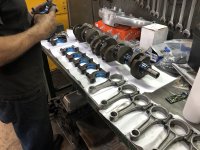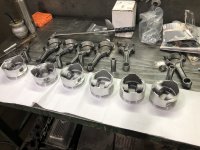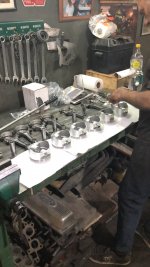Yes I think they maybe the same bore size as the stock 200 pistons but they would have a different compression height. So in that case you have the potential of from 221 cu. in. (with standard bore block and standard stroke 221 crankshaft) and up to about 228 cu.in. depending on oversized bore of the block plus the ability to offset grind the crank a little depending on which rods that are used and their big end size:
You are using an out of date browser. It may not display this or other websites correctly.
You should upgrade or use an alternative browser.
You should upgrade or use an alternative browser.
200/3.3L crankshaft questions
- Thread starter fast64ranchero
- Start date
In the below link is an old tech article on how to build a 223 cu.in. out of a US 200 block. It has one typo in it on the cu. in. (53 extra instead of the correct 23 cu.in. Extra) that is easy enough to see. Enjoy https://fordsix.com/ci/stroker200.html
So thank you to our new member Tom we now know the 221 and 188 blocks have a 93.47 MM Bore Size which rounded off equals 3.680 This is the same as our USA 200’s blocks bore.
The 221 crankshaft Stroke is 87.58 MM equals 3.447
The 188 Crankshaft Stroke is 74.67 MM equals 2.934. Hum this is about the stock stroke of our 170’s so Ford just used the same 221 tall deck blocks with the 170 crankshaft in them.
The 188 rod length is 137.4 MM equals 5.409
The 221 rod length is 130.3 MM equals 5.130.
not sure we could use these longer rods in a 200 block haven’t did any of the math yet.
The 221 crankshaft Stroke is 87.58 MM equals 3.447
The 188 Crankshaft Stroke is 74.67 MM equals 2.934. Hum this is about the stock stroke of our 170’s so Ford just used the same 221 tall deck blocks with the 170 crankshaft in them.
The 188 rod length is 137.4 MM equals 5.409
The 221 rod length is 130.3 MM equals 5.130.
not sure we could use these longer rods in a 200 block haven’t did any of the math yet.
TomCanz
New member
I think I explained it wrong, the diameter/ bore is 93.47mm as the blocks are the same but they have a different stroke. The measurements of the rods are between axial centers ñ of the piston pin and the crankshaft.So thank you to our new member Tom we now know the 221 and 188 cranks have a 93.47 MM stroke which rounded off equals 3.468.
The 221 Bore Size is 87.58 MM equals 3.447
The 188 Bore Size is 74.67 MM equals 2.934
The 221 rod length is 137.4 MM equals 5.409
The 188 rod length is 130.3 MM equals 5.13
The modification we make is to use the 221 crankshaft, with the 188 rods and modified pistons with floating bolt that compensate for those 7.1mm of height difference. The pistons are smaller, which they weigh less, so less mass allows to move faster.
What we achieve with this is that the rod remains in an upright position, with less lateral wear of the walls of the
cylinder. The engine is lighter, has a better response and climbs RPMs faster compared to an engine without this modification.
Thank you Tom for the clearing that up, we are glad to be able to learn about those unique parts you have available to you there and the hot rod tricks that are also used. But I know I got some of parts measurements arranged wrong too. I edited the above post hope it’s correct now.
Jmustang_65
Famous Member
Use this thread for details. Should be 23 more cubesSo a 221 crank in a 200 block creates what displacement? The 200/221 pistons are not same bore size right?
93.47mm is 3.680 "
Not 3.480"
Not 3.480"
So thank you to our new member Tom we now know the 221 and 188 blocks have a 93.47 MM Bore Size which rounded off equals 3.468. This is quite a bit smaller than our 200’s blocks bore at 3.680.
The 221 crankshaft Stroke is 87.58 MM equals 3.447
The 188 Crankshaft Stroke is 74.67 MM equals 2.934. Hum this is about the stock stroke of our 170’s so Ford just used the same 221 tall deck block with the 170 crankshaft in them.
The 188 rod length is 137.4 MM equals 5.409
The 221 rod length is 130.3 MM equals 5.130.
Hum and I used an online MM to inch calculator. I even redid it several times but that’s what always came up, o well that’s way better since that’s the stock 200 bore. I really hate the Metric system to me it’s to much work at my age anyway. Thanks for the correct answer! The only thing left to find out is the 188 & 221 SPS block deck height to compared to our 200 block decks and maybe the weight to.
The data in the Inlines file on conrods has and is and always has been wrong on conrod lengths and the phase in dates of alloy heads.
For 188 and 221's, the Aussie 3.1 Litre and 3.6 Litre decks are all 8.425".
Give or take some.
188/221's followed the 250 crank to cam spacing, so a 144/170/187 or 200 wont take a 3.46" 221 crank without using 1.899" journal, 5.25" long, 0.866" wrist pin Holden XT5 or Holden 1900 Starfire/Phase3/ Toyota 1X 1900 rods. Or a 5.375" Rabbit/Golf Diesel or VW/Audi/Volvo Diesel conrod. The 3.25" storke 1980-1985 XT5 "Blue"/XT6"Black" 3.3 litre crankshaft is a 12 counterweight item which can fit the 200 block if the crank and snout are interference spigot welded. It used the Ford bore centers of 4.08" to save production costs. The 1948-1962 Holden Grey motor and Desp Skirt Vauxhall 138's and VX4/90's shared the 3.779" Kent in line four and six bore center spacings used on the old Zephyrs and Counsel's as well as the 105E based Anglia's. It means crank casting or forgings can be shared. Nissan copied the Ford and GM bore spacings on its L series fours. That's how business is done.
The 1984 2.3 HSC was 8.66 deck,
the 1986 2.5 HSO was 9.38 inch deck,
the 1968 US 250 was 9.469 inch deck
the tall deck 1971 Aussie 200/250 was 9.38 inch deck
The growth happened when the Australia's Ford range via Bill Bourke needed much better and more reliable Bendix Technico carbs, Bosch ignition systems and bigger Borg and Beck clutches and bellhousings to fit the new Volvo and Fairlane 260 160 tooth flywheel used with the up and coming Volvo 144/164's English sourced US designed Borg Warner 35 trans. Most of these parts were to be made in Aussie materials smeltered with local Bauxite and Toyota spent most of its time repurposing AMC shock absorber's and Holden V8 timing chains, which is why a Crown uses AMC shocks, Commodore A rear suspension pick-up points and the 18R uses a Ford 302 timing chain set also used in Mike1157's old Glia Monster. Its an HQ 308 part...
Ford Broadmeadow's was forced to negotiate with the likes of Tonsley Park Chrysler, Fishermen's Bends GM- Holden and Port Melbourne's AMI (A defunct Studebaker, and now AMC-Toyota consortium), and BMLC Zetland NSW. before the 85% local content laws came in place in 1968. That ment export markets for all five bespoke auto makers, with the set up of a local wing to assemble other English, French and Jap cars as well.
The 8.425 deck Australian block wasn't the first change form the narrow block US 144/170/200 type. The 1962 four bearing Argentine 187 stroker was.
Then the Saginaw Argentine bellhousing,
then the bolt on adaptor mid 1964 170/200 XP automatics,
then the wide block 188/221 shared with Argentina's.
The first deck height increase was 1968 with the XT Falcons and Aussie Fairlane's
For 188 and 221's, the Aussie 3.1 Litre and 3.6 Litre decks are all 8.425".
Give or take some.
188/221's followed the 250 crank to cam spacing, so a 144/170/187 or 200 wont take a 3.46" 221 crank without using 1.899" journal, 5.25" long, 0.866" wrist pin Holden XT5 or Holden 1900 Starfire/Phase3/ Toyota 1X 1900 rods. Or a 5.375" Rabbit/Golf Diesel or VW/Audi/Volvo Diesel conrod. The 3.25" storke 1980-1985 XT5 "Blue"/XT6"Black" 3.3 litre crankshaft is a 12 counterweight item which can fit the 200 block if the crank and snout are interference spigot welded. It used the Ford bore centers of 4.08" to save production costs. The 1948-1962 Holden Grey motor and Desp Skirt Vauxhall 138's and VX4/90's shared the 3.779" Kent in line four and six bore center spacings used on the old Zephyrs and Counsel's as well as the 105E based Anglia's. It means crank casting or forgings can be shared. Nissan copied the Ford and GM bore spacings on its L series fours. That's how business is done.
The 1984 2.3 HSC was 8.66 deck,
the 1986 2.5 HSO was 9.38 inch deck,
the 1968 US 250 was 9.469 inch deck
the tall deck 1971 Aussie 200/250 was 9.38 inch deck
The growth happened when the Australia's Ford range via Bill Bourke needed much better and more reliable Bendix Technico carbs, Bosch ignition systems and bigger Borg and Beck clutches and bellhousings to fit the new Volvo and Fairlane 260 160 tooth flywheel used with the up and coming Volvo 144/164's English sourced US designed Borg Warner 35 trans. Most of these parts were to be made in Aussie materials smeltered with local Bauxite and Toyota spent most of its time repurposing AMC shock absorber's and Holden V8 timing chains, which is why a Crown uses AMC shocks, Commodore A rear suspension pick-up points and the 18R uses a Ford 302 timing chain set also used in Mike1157's old Glia Monster. Its an HQ 308 part...
Ford Broadmeadow's was forced to negotiate with the likes of Tonsley Park Chrysler, Fishermen's Bends GM- Holden and Port Melbourne's AMI (A defunct Studebaker, and now AMC-Toyota consortium), and BMLC Zetland NSW. before the 85% local content laws came in place in 1968. That ment export markets for all five bespoke auto makers, with the set up of a local wing to assemble other English, French and Jap cars as well.
The 8.425 deck Australian block wasn't the first change form the narrow block US 144/170/200 type. The 1962 four bearing Argentine 187 stroker was.
Then the Saginaw Argentine bellhousing,
then the bolt on adaptor mid 1964 170/200 XP automatics,
then the wide block 188/221 shared with Argentina's.
The first deck height increase was 1968 with the XT Falcons and Aussie Fairlane's
Last edited:
Thank you Xctasy, yes I remember you mentioning about the wrong info and measurement data in the old tech section wish I could edit it to correct that's wrong. I know there is some miss info on the 1975 / 1976 large log heads. Might be easy enough to rewrite it all, if I know what's right and what's wrong. Anyway I am glad you took the time to correct the miss info in this post. Since we never had the 187, 188, or the 221's in the US they have been a curiosity to me. I tried as far back as the late 1970's to get one of the iron 2V heads from Australia (my cuss was in the Navy and making a trip there) and I never knew about the 221 SPS heads and engines they had in Argenta until seeing a couple parts from them on this site. Those Holden engine crankshafts have any crossover to the Chevy or Pontiac six's they built here in the US?
Thank you Xctasy, yes I remember you mentioning about the wrong info and measurement data in the old tech section wish I could edit it to correct that's wrong. I know there is some miss info on the 1975 / 1976 large log heads. Might be easy enough to rewrite it all, if I know what's right and what's wrong. Anyway I am glad you took the time to correct the miss info in this post. Since we never had the 187, 188, or the 221's in the US they have been a curiosity to me. I tried as far back as the late 1970's to get one of the iron 2V heads from Australia (my cuss was in the Navy and making a trip there) and I never knew about the 221 SPS heads and engines they had in Argenta until seeing a couple parts from them on this site. Those Holden engine crankshafts have any crossover to the Chevy or Pontiac six's they built here in the US?
Which page is wrong? I have been converting some of these to the 'Articles' system here, which we can then edit in a sane way.
No. The earlier Holden 3.779" bore spacing engine was what the 1955 to 1960 Vauxhall engine become, but was US Chevrolet designed. The US in line sixes are all 4.40" bore spacing. The GM 4200, 4.05", same as the Cavalier/Cimarron engine, if I recall. Opel Family II OHC based bore spacing.Those Holden engine crankshafts have any crossover to the Chevy or Pontiac six's they built here in the US?
Hence the 4.08" bore spacing was a 100% GM copy of the Ford Falcon engine, just like the 3.78" inch bore spacing 1951 Ford Zephyr/Counsel/Zodiac was a 100% copy of the 3.78" inch 1948 Holden Grey Motor (1936 Chevrolet/1955 Vauxhall small car design) bore spacing engine.
And kind of like Dick Ronzi's Chrysler D series 4.46" Bore center Hemi intake manifold on the Cross flow OHC 240/300 4.48" bore spacing BIg Six
Has anyone ever built something like this?
That would be pretty cool,a 4.5"x4.5" bore and stroke 429-6. If you go for for it I will be watching your build.
Copy is not nepotism or theft, but a "Devine sense of respect" in my humble opinion.
The Boss 302, Cleveland 335 and Lima 385 engines got the best rocker sled fulcrums and retainers from Chevrolets Big Block Mark IV 427, after all.
as for the Medium deck 188/221 corrections and details, many, many times raised from 2007 to 2018. The wrong bitz in blue, with a post further below on the specific's. If it was the Wolf, it would've bitten ya'll.
I'm a 70 times 7 guy. After 490 perceived wrong's, I then ask G""d to extract your eyes and teeth, through your a$$

Build a hot 200
Ok, as i am confused with these little engines i will outline what i am trying to do, my car is a 1967 XR wagon, original 200 super pursuit with 3 spd manual and 75 series rear. I wanted to upgrade relatively cheaply to hot little six, C4 auto and a 78 series diff. So far i have done this to the...
221 high performance parts
Hello. Can anyone tell me if high performance parts for the 221 are readily available and where to get them from. Im talking about things like pistons, cam, rods.... and so on. Cheers. I live in melbourne.
221 now on the operating table, The build begins
Hey guys, New to the forums so i will start with what i have and what's going to be done first. I have a 1965 XP sedan, my dad has given this to me as a first car. So going to be doing it up/restoring it to drive on my P plates. I have a 221 to go in it and a list of mods. Last week i...
Here is my amended A7M Aussie 7 Mains list of http://fordsix.com/aussiesixes.htm
C.I.
BORE
STROKE
ROD
YEARS
144
3.5
2.5
4.7
1960-1966
Integral Manifold
170
3.5
2.94
4.7
1960-1966
Integral Manifold
188
3.68
2.94
5.4
1967-1969
Integral Manifold
200
3.68
3.13
4.7
1966-1967
Integral Manifold
200
3.68
3.13
6.27
1971-1976
Integral Manifold
221
3.68
3.46
5.51<<<<-----Wrong: 5.14" <-------Right.
1967-1969
Integral Manifold
250
3.68
3.91
5.88
1970-1973
2V head
250
3.68
3.91
5.88
1976-1980
Iron X-flow
250
3.68
3.91
5.88
1980-1992
Alloy X-flow
191
3.6
3.13
6.27
1988-1990
OHC
239
3.6
3.91
5.88
1988-1990
OHC
240
3.64
3.91
5.88
1990-1998
OHC
240
3.64
3.91
6.00<<<<6.06
221 Stroked 200 - Myth or Reality
I’ve been searching the forum for information regarding the 221 Stroker article in the Tech Archive. I haven’t read everything, I’m sure, but what I’m wondering is if there is anyone here on the forum that has actually built one. There are a number of threads that discuss what parts and offsets...
Last edited:
Similar threads
All Small Six
Ford 200
- Replies
- 9
- Views
- 1K
- Replies
- 17
- Views
- 2K
All Small Six
What's the most powerful 144 you've seen?
- Replies
- 12
- Views
- 550
- Replies
- 4
- Views
- 1K
- Replies
- 26
- Views
- 3K



